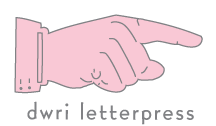Hot metal type linecasting machines were developed in the later part of the 19th Century to automate the individual typecasting and hand typesetting that had been the standard in commercial printing since Gutenberg cast handset type in 1455. Brass type matrices are set (automatically from a keyboard on a Linotype, set by hand on a Ludlow) and then cast instantly from a crucible of molten lead onto a single line, or slug, of type. Unlike handset type, this will be brand new, never used before type, which can then be melted and reused in future projects.
We offer typecasting services to fellow letterpress printers, bookbinders, artists of all sorts, and to the trade. Ludlow type can be cast from 6 to 96pt, with special 244pt Bodoni Campanile numbers, and is traditionally used for “display type” in headlines, chapter heading, larger type in posters, etc. Linotype type is cast from 6 to 18pt, is much faster then Ludlow typecasting, and for these reasons was used primarily for “body type”, the larger mass of type in book pages, newspaper columns, etc. Linotype slugs are cast at 30 picas, ludlow slugs at 22 1/2 picas, but multiple lines can be cast together up to 90 picas long.


